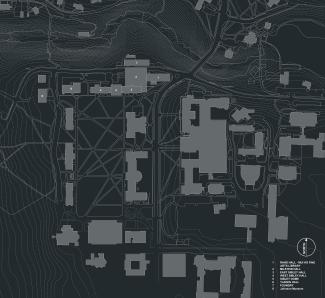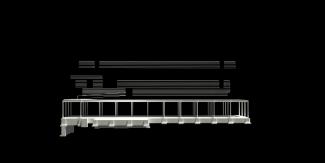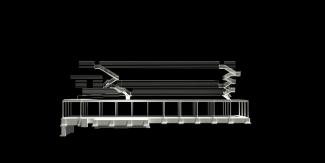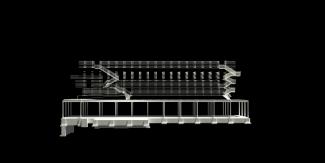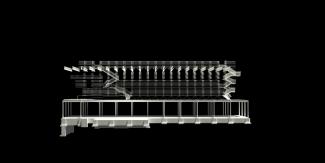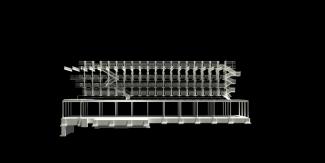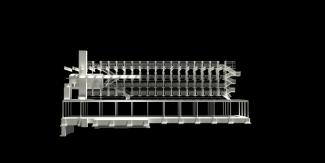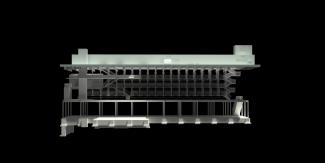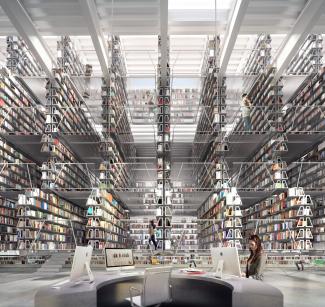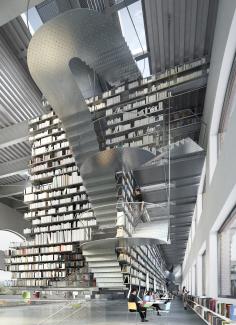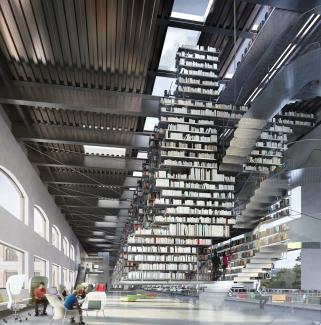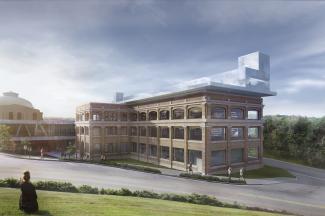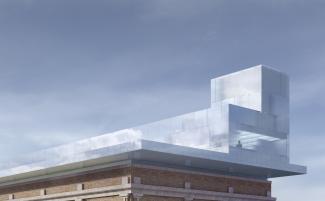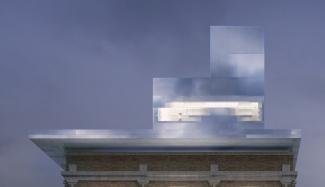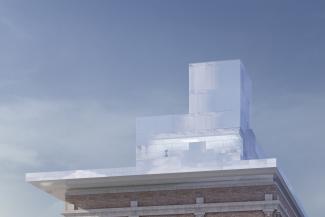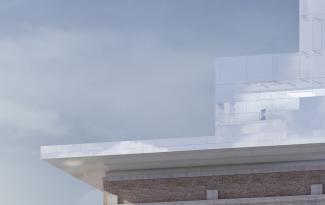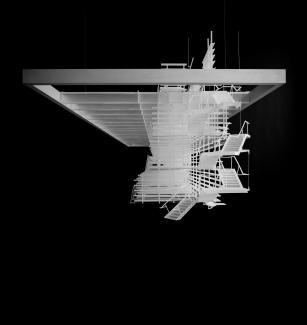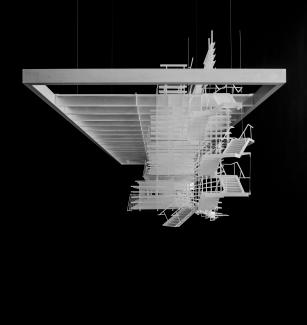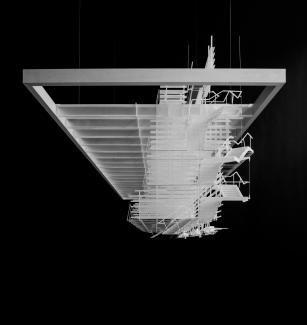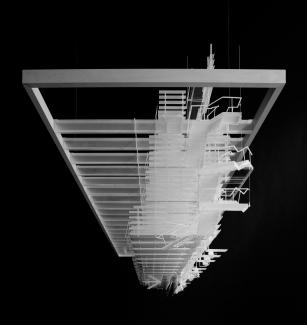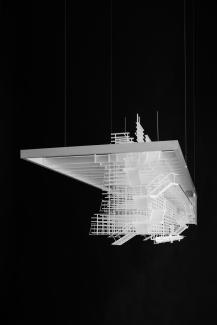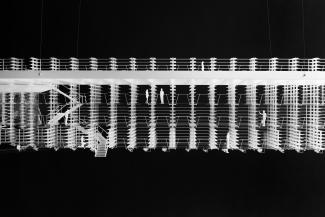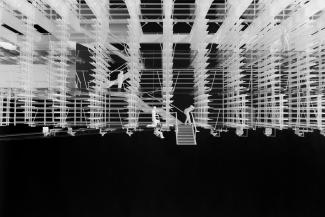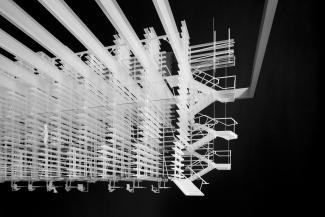1. THE GROWING LIBRARY
To be a building for a library is not easy. In the beginning of their existence they are often way too big for that what they should contain and as they age they tend to be too small. A library is a very often an organism which changes size, which grows and sometimes decreases, which sometimes needs vast amounts of space and sometimes leaves its containment to infiltrate additional others.
Of course, the ideal case for a library would be a building, which is able to change size, a building which could grow. Such a requirement would lead us to a concept different from the building as a frozen formal and tectonic entity. It could lead us to bionic skins, it could lead us to psychedelic visions of
the sixties or it could lead us to a concept embedded in the famous painting by Pieter Bruegel “the Elder of the Tower of Babel” (1563), a building being never finished, always under construction, always ready to grow, always ready to become taller.
2. THE BREATHING LIBRARY
An expanding and contracting organism:
Part of our project for the new University for Applied Arts in Vienna is a Library for Applied Arts. In the course of the extension of the University the Library should be repositioned in an existing part of the University which is not large enough to house all collections of the library, and not large enough to house anything other than tightly spaced repetitive book stacks.
The most convincing scheme, for architect and Client as well, was to accept exactly that challenge and make the stacking as dense as possible. Crucial for the concept is, that not a standard shelving system was selected, but instead a mobile shelving system was devised, which allows for an ongoing transformation of the libraries' spaces. The transformation of spaces should follow a clearly defined curatorial concept which involves the programming of time and space as agents to be designed. It enables the library to house events which otherwise could not happen.
3. THE LIBRARY WITHOUT BOOKS 1
An experimental physical space:
The two-stage international competition for “Bauhaus Europe” was launched in the summer of 2005. Among others, a curatorial study by Okwui Enwezor and a project study by OMA/AMO served as the basis for the competition. The second stage of the competition for Bauhaus Europe was decided in January 2006. The jury recommended the execution of the project by Wolfgang Tschapeller ZT GmbH. A public referendum in the same year brought the project to a halt.
What was quiet remarkable about the “Bauhaus Europe” project was the fact that there was no precedent, neither for its functioning nor for its spatial formulation. It had to be invented anew. It could have been a mixture of a museum and a library type of space, where documents and artefacts of the building of a common Europe would be exhibited. Instead we decided to layout a spatial map containing the marks of Europe´s history, the so called Index, together with a moving bridge, sliding and transporting the visitor silently above the spatialized Index of Europe´s history.
4. THE LIBRARY WITHOUT BOOKS 2
Libraries, as functional entities, are precisely placed on the cutting edge between digital space and physical space. During the last decades artists and engineers were providing projects along that cutting edge.
Wolfgang Tschapeller ZT GmbH is authoring an ongoing research attempt on the fusion of virtual and physical space, pointing towards a new type of space, called INTRASPACE in allusion to Karen Barad´s concept of intra-action.
The research project is based on Wolfgang Tschapeller’s project „hands have no tears to flow“ presented in the Austrian Pavilion at the Venice Biennale in 2012. Both, the Biennale project and the research project involve a series of experiments regarding the intra-action between physical and digital characters, which require a remarkable technical capacity in terms of technical expertise and invention.
As an illustration of a possible digital project for a Fine Arts Library a project by Dennis Del Favero, Jeffrey Shaw, Neil Brown and Peter Weibel of 2008 might serve, where enormous amounts of video clips are simultaneously displayed and distributed around a circular screen. „Using a special interface the viewer can select, re-arrange and link video clips at will on a “… public screen … „ composing them into combinations based on relations of gesture and movement … It is the experience of this new kind of spatial connectivity that gives rise to a revolutionary way of seeing and re-conceptualizing“… visual information...“ in its aesthetic, physical and semantic dimensions.“
(Jill Bennet)
5. THE LIBRARY OF FINE ARTS
Is a Library of Fine Arts different from a Library of Natural Sciences? Is there any difference? Should there be a difference? Must there be a difference?
I would say, yes.
Art, artists and theoreticians in the 20th and 21st century gradually identified media, the process of publication and means of communication as a field of artistic research. With that, the text, the book and related media were gradually recognized as potential embodiments of an artistic process and more importantly, the practice of perception, the practice of reading and analysis was extremely widened and enriched by the artist’s involvement. Because of that we might argue, that the organization of a Fine Arts Library in certain aspects has to integrate the potential of an artistic practice of reading. A very few selected references are the works of the artists: Joseph Kosuth, Bernhard Cella, Clegg & Guttmann, Franz West, and of course Rachel Whiteread with the Judenplatz Holocaust Memorial in Vienna, a reversed library with books cast in concrete, where instead of the spines of books, the backsides of books are turned towards the visitors.
Bernhard Cella, an artist operating in Vienna, Berlin and Paris established in 2002 his “Salon für Kunstbuch”, an art book store one might say, but then the store surprises by a particular type of sculptural “minor architectures” and a series of surprising programs, which are in parts mirrored in the stores website, which e.g. (to name the more bold and striking ones) foresees a selection of books by the color of their covers. That is, you could have a selection of yellow books, which on the first hit produce titles such as “Gardens of Distance”, “Stealth Architecture”, “Parallel Cards” or “Avantgarde, Experiment and Underground”. Another example of a show presented all 69 title pages of Hans Ulrich Obrist’s publications as watercolors, giving you painted titles such as “Hans Ulrich Obrist and Olafur Eliason”, “Laboratorium”, “Did someone say participate?” or “Everything you always wanted to know about curating, with a foreword by Tino Sehgal and an afterword by Yona Friedman”.
(twa)
HANGING BOOKS, BACKSIDES OF BOOKS, MEZZANINE SHELVING, POROUS GRATINGS, VERTICAL VOIDS, HORIZONTAL VISTAS
Cornell´s new Fine Arts Library consists of a variety of working and office spaces and one central, generous, main reading space which is equipped with a longitudinal lantern. Into that lantern a mezzanine shelving construction is mounted, containing 45 arrays of shelves, each of them consisting of 6 shelf trays on 3 levels. The arrays of shelves are hung in a distance of 5´ to each other. Between them, metal grating floors are mounted, so transparent, that a vertical void rather than a horizontal floor between the shelves is suggested, and so porous, that an effective and subtle air movement between the hanging shelves is supported. Light and air move vertically trough the horizontal layers of metal gratings.
The mezzanine shelving system is the most economic means of storing books. It is applied in Cornell´s Libraries Annex, the Cornell A.D. White Room, the Pratt Institute Architecture Library in Brooklyn and the Avery at Columbia University to name only a few. In Cornell´s new Fine Arts Library a fusion of the economy of object defined book storage and generous user defined reading spaces is proposed.
Then, there are the hanging books. They date back to one of the first projects of our practice. We were asked to renovate and make publicly usable Sigmund Freud´s apartment in Berggasse 19 in Vienna. One of the tasks was to insert a small library with selected books, in fact, right in the earlier sleeping room of Sigmund Freud. Since the floor constructions were worn out and sagged towards the middle of the space the book shelves could not be placed on the floor, instead they had to be attached directly onto the walls and what we proposed and executed then, was a system which is hung onto the bearing walls and does not touch the floor. In retrospective only, we registered that structural needs made apparent the paradox of weightless knowledge embedded in the heaviness of compacted paper. Recalling that experience, the entire volume of more than 100.000 books of Cornell´s new Fine Arts library was constructed as a floating volume hanging from the roof beams, not to ground and not to floor, but 4´10´´ above the floor, leaving a free space, a void, not to enter but to allow for a free vision for those who sank down in an easy chair by reading a book.
(twa)
LET US TRY TO LAY OUT A FEW THOUGHTS
1.
Let us try to lay out a few thoughts. Rand Hall is an interesting structure and we are using the term structure versus the term building intentionally, since the term building often generates a certain schematic reading, whereas the term structure stimulates a more open, a more unprejudiced reading. In fact, in talking about Rand Hall we should talk about 2 structures. One of them is a heavy, massive, neoclassical masonry shell. The other, a filigrane functional steel skeleton which is concealed by the earlier. An interesting overlapping condition, since one of them stands for the disappearance of a historic style and the other – the steel skeleton - for the emergence of a functionalist approach towards space and structure. And in 2014 it was exactly the steel skeleton, which we based one of four of our proposals on and which was then selected by the University for realization.
2.
The new Rand Hall is not only a library and a models shop. Both of them together are a conceptual model for an architecture and art school. Shops, model making, prototypes, and mockups stand for the material component of architecture, whereas the library stands for the conceptual component of architecture. On first floor a noisy, dusty, and dirty fabrication place full with machines and on second floor a silent and clean space where more than 100.000 volumes of books are hung between earth and the skies. Thus we have two factories in one building. One is the factory for models and one is the factory for thought and concepts. Both of them are wrapped by Rand Hall to one interacting volume.
And then there is the roof platform, which originated at a very difficult point in the projects history, when budget constraints forced us to reduce the project drastically and as a consequence the empty roof was proposed by our office as a platform for experimentation, exhibition and experimentation, allowing students to present their work on the roof at one of the entrances to the campus, thus making visible aspects of the creative work produced at the College for Art, Architecture and Planning. Ironically, only later we learned that Buckminster Fuller had used the roof of Rand Hall in 1954 already as a presentation platform for one of the geodesic domes.
3.
FAL is our first project in the US and of course, we have experienced a whole list of differences. A different planning culture, a different client consultant relation, a different client structure, different building technologies, different approaches in regard to climate issues, and especially not being in full control of the planning and construction process.
What makes it certainly special is, to make as an architect a library for students of architecture, art and planning and to do that in a building where you yourself taught and studied architecture.
4.
Certainly the wrapping in one building of shop, library and experimentation platform on the roof is one of the relevant characteristics. Then, to have more than 100.000 books together in a hanging structure. Then, to be able to see the major portion of books from the reading room. Then, to see the backside of books on the east and north side. Then, of course the stacks, with their metal grating, the metal grating allowing transparency and the necessary airflow between the floors, to see as visitor from the fourth to the second floor through the grating, to look up and to see moving silhouettes above you, views and overlapping realities between inside and outside, the mirror roof piece, which sometimes disappears completely and sometimes glows orange, sometimes silver, sometimes reflects the street´s red light, sometimes is an extension to the skies.
(twa)
Fluid Library Systems were discussed in the course of the design process. Up to the design development stage a limited area of FAL was planned as Fluid Library.
Fluid Library [term established by Olaf Eigenbrodt]
Chaotic Storage [term originating from …]
Dynamic order [term used by Sitterwerk Art Library]
A FLUID LIBRARY
Scenario 1 “Zusammenstellungen” [German for composition, arrangement, constellation]
Artists, invited guests and individuals are curating the library’s collection by composing their individual selection from the content of the library. As the library collection grows over the years, so do the curated arrangements, adding another layer of reading and display to the existing collection.
The Art Library Sitterwerk in Switzerland has converted their entire collection of books and material library into a Fluid Library, or, how they call it, into a dynamic order. As a visitor of Sitterwerk library I enter a space with a wall full of books on the one side and a tower of drawers full of various materials on the other. In the middle of the space, there are a few tables and surfaces for display. All items of the library are tagged with an RFID chip, table and presentation surfaces with an RFID reader.
On the shelves, a robotic arm is parked. This robotic arm is carrying another RFID reader. At night, the arm begins to travel along the entire length of the shelf reading the location of each book. On a 150 minutes scanning tour the precise position of every item of the Fluid Library is updated, however, this nightly scan intervals cause for items which were moved in between the most recent interval an uncertainty about their position up to 24 hours. As a consequence the placement of each book is a fragile condition. The library is no longer a rigid and fixed entity, but a fluid condition. For example, a visitor would not be able to spot a book which was taken out and brought back to another location on that day – the new location will only be registered at night. Because of the low frequency of visitors at Sitterwerk, this uncertainty is not relevant. Then, a visitor could have taken out a book and placed it on one of the RFID reader equipped tables. Then, of course, the book would be registered. When visitors enter the library at Sitterwerk there is a PC with the catalogue (you can also enter and search the catalogue from home) and I find a book of my interest. It is not classified with the conventional library labeling (German: Signatur), but is positioned in a grid like coordinate system on the screen. The grid on screen and in reality is tagged with numbers in the horizontal and letters in the vertical. Not only the current position of the book is traceable, also its entire history of positions and neighborhoods in the shelf. As materials of the material archive are also equipped with RFID tags, the compositions can include materials and books alike. There is a productive link between the artistic work of invited artists at the studios and their choice of literature and materials in the library space that is available for every user and can be traced over time and across events, exhibitions and other activities at the library. Books and materials in the library are no longer individual, separated items with their inherent references, but have been reaching out, entered and left other constellations. This allows a visitor not only to follow conventional research practices, but also to follow other paths and get attracted by unknown relations. Such can be discovered digitally in the library’s catalogue and in online “Zusammenstellungen” and at the same time displayed on the sensitive, reader equipped furniture in the physical space. Such surfaces act like exhibition spaces, which can be explored. Thanks to the very principle of the RFID it is possible to have the cover, the books´ outside appearance, untouched.
Scenario 2 Course Reserves
Lecturers and professors can use the Fluid Library as a highly dynamic physical and digital extension of their courses and studio projects. Physical books and documents are placed in the zone where they are then freely rearranged by the students while traced and densified with content digitally.
As a professor of the AAP faculty staff, I select a reading list, documents and materials for students to read and work with. I identify the items in the CUL online catalogue, those not part of the FAL collection can be ordered. In case they are not equipped with an RFID tag, the FAL library staff would attach a tag to the book and link it digitally to the catalogue. Then, I move my selection of materials and books and place it in the area of the library equipped with RFID reading furniture and shelves – the Fluid Library. From that moment on, selected books and materials are traceable. Contrary to the reading device that travels along the shelves in Sitterwerk, here all the surfaces have integrated antennas and the capacity to localize every item continuously. A real-time system, turning the book, that is knowledge, into a dynamic object in real space with varying neighborhoods. Students can compose and rearrange books freely in designated areas. The figuration is never the same. New book neighbors every time I visit, books produce new relationships not limited to the list I have selected, but widen across all the material placed in the Fluid Library. Students and teachers work and research digitally and physically in dynamic and ever-changing constellations.
Scenario 3 Curated Compilations in relation to events and exhibitions
In parallel or immediate response to current exhibitions, activities or geopolitical, cultural or social events the collection of FAL/CUL can be curated with books and materials displayed in the Fluid Library. This turns the library space into an active extension of other institutions and activities on campus and beyond.
As a curator I could use the Fluid Library area on the one hand to deepen the context of a current exhibition at for example the Johnson Museum of Art and on the other hand approach a different audience in an academic context. For the library its presence on the campus would increase and attract new visitors. As a curator of an exhibition I could also make use of the Fluid Library for educational programs run by the museum in cooperation with the library, linking teaching, research, and the museum. I could find books in the libraries’ collection, but could also – for the time of the exhibition – bring in additional books and media to the Fluid Library. Students going to the Fluid Library for course reserves are finding unexpected material and books next to the ones they have been looking for.
The digital collection of the museum and digitized books and media of the library can be brought together as one resource in a dynamic environment. After the exhibition is closed the composed material is collected and made available in the digital catalogue as an archive of the museum’s concepts and approaches. Timothy Murray and the Rose Goldsen Archive for New Media could be potential partners. Timothy Murray is especially familiar with curating different media and exposing it to different public and academic contexts.
Scenario 4 Interdisciplinary Research Project
Researchers from different fields and departments, even entire universities, are contributing books and media to a collection in the Fluid Library. Books, not part of the FAL collection have a temporary presence in the library.
As a PhD or PostDoc student working in an interdisciplinary research group or laboratory I could share methodologies and resources within the group and together establish a digital and physical compilation that can be discovered by other single PhD students and academics in the setting of the Fluid Library. While the physical library space allows me to work in an associative and dynamic manner as a group and individual, the digital shelf allows to create versions of the same content to which I could refer or get back to wherever I work, even if enrolled and studying at a different university. Indications of reference routes and material found by chance in proximity to mine constitute the potentials of research work in the Fluid Library. Beyond that, and potentially even more relevant than in Scenario 2, the possibility to trace and as a consequence analyze and understand paths of knowledge production while also understanding one’s own development could be a helpful tool, creating a meta-level. All members of the research group use the Fluid Library as a repository for their material. Together with other facilities at the FAL library the Fluid Library becomes a multi-dimensional interactive research environment which is not only actualized by activities of the research group, but through all the users of the library together.
(twa)
